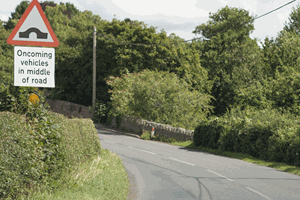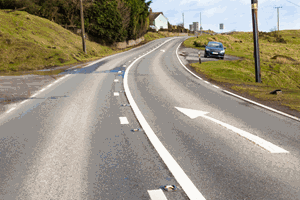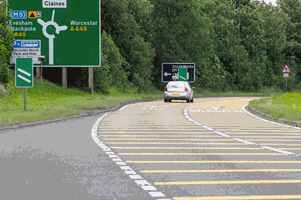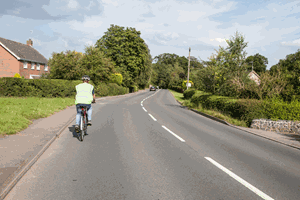There are 26 driving theory test Alertness questions. You must get 86% (22 out of 26) to pass the test. You may review answers after each question by clicking the 'check answer' button or you can wait until the end of the test for your final score. Good luck!
Car Theory Test Categories (2025)
Test Quick View
Click question box to reveal the correct answer. You can print these questions out by clicking the printer icon.
Correct Answer: C
Explanation: If you have to make a U-turn, slow down and ensure that the road is clear in both directions. Make sure that the road is wide enough for you to carry out the manoeuvre safely. Use your mirrors and look round to check it's safe before turning across the road.
Explanation: If you have to make a U-turn, slow down and ensure that the road is clear in both directions. Make sure that the road is wide enough for you to carry out the manoeuvre safely. Use your mirrors and look round to check it's safe before turning across the road.
Correct Answer: D
Explanation: You should slow down and be cautious. Hump bridges are often narrow and there may not be enough room for you to pass an oncoming vehicle at this point. Also, there's no footpath, so be aware of pedestrians in the road.
Explanation: You should slow down and be cautious. Hump bridges are often narrow and there may not be enough room for you to pass an oncoming vehicle at this point. Also, there's no footpath, so be aware of pedestrians in the road.
Correct Answer: A
Explanation: Oncoming vehicles or other hazards can be hidden from view by dips in the road. If you can't see into the dip, wait until you have a clear view and can see that it's safe before starting to overtake.
Explanation: Oncoming vehicles or other hazards can be hidden from view by dips in the road. If you can't see into the dip, wait until you have a clear view and can see that it's safe before starting to overtake.
Correct Answer: B
Explanation: In this picture, the road marking shows that overtaking drivers or riders need to return to the left. These markings show the direction drivers must pass hatch markings or solid double white lines. They're also used to show the route that high vehicles should take under a low arched bridge.
Explanation: In this picture, the road marking shows that overtaking drivers or riders need to return to the left. These markings show the direction drivers must pass hatch markings or solid double white lines. They're also used to show the route that high vehicles should take under a low arched bridge.
B
C
D
Correct Answer: B
Explanation: It's illegal to use a hand-held mobile or similar device when driving or riding, except in a genuine emergency. The safest option is to switch off your mobile phone before you set off, and use a message service. If you've forgotten to switch your phone off and it rings, you should leave it. When you've stopped in a safe place, you can see who called and return the call if necessary.
Explanation: It's illegal to use a hand-held mobile or similar device when driving or riding, except in a genuine emergency. The safest option is to switch off your mobile phone before you set off, and use a message service. If you've forgotten to switch your phone off and it rings, you should leave it. When you've stopped in a safe place, you can see who called and return the call if necessary.
Correct Answer: C
Explanation: These lines are often found on the approach to a roundabout or a dangerous junction. They give you extra warning to adjust your speed. Look well ahead and do this in good time.
Explanation: These lines are often found on the approach to a roundabout or a dangerous junction. They give you extra warning to adjust your speed. Look well ahead and do this in good time.
7. What should you do when you're approaching traffic lights that have been green for some time?
Mark one answer
B
C
D
Correct Answer: B
Explanation: The longer traffic lights have been green, the sooner they'll change. Allow for this as you approach traffic lights that you know have been green for a while. They're likely to change soon, so you should be prepared to stop.
Explanation: The longer traffic lights have been green, the sooner they'll change. Allow for this as you approach traffic lights that you know have been green for a while. They're likely to change soon, so you should be prepared to stop.
Correct Answer: D
Explanation: Before slowing down or stopping, check the mirrors to see what's happening behind you. Also assess what's ahead and make sure you give the correct signal if it will help other road users.
Explanation: Before slowing down or stopping, check the mirrors to see what's happening behind you. Also assess what's ahead and make sure you give the correct signal if it will help other road users.
B
C
D
Correct Answer: B
Explanation: If you're following a large vehicle but are so close to it that you can't see its exterior mirrors, the driver won't be able to see you. Keeping well back will also allow you to see the road ahead by looking past the large vehicle.
Explanation: If you're following a large vehicle but are so close to it that you can't see its exterior mirrors, the driver won't be able to see you. Keeping well back will also allow you to see the road ahead by looking past the large vehicle.
Correct Answer: C
Explanation: You should be constantly scanning the road for clues about what's going to happen next. Check your mirrors regularly, particularly as soon as you spot a hazard. What's happening behind may affect how you respond to hazards ahead.
Explanation: You should be constantly scanning the road for clues about what's going to happen next. Check your mirrors regularly, particularly as soon as you spot a hazard. What's happening behind may affect how you respond to hazards ahead.
11. You're waiting to turn right at the end of a road. What should you do if your view is obstructed by parked vehicles?
Mark one answer
B
C
D
Correct Answer: B
Explanation: At junctions, your view is often restricted by buildings, trees or parked cars. You need to be able to see in order to judge a safe gap. Edge forward slowly and keep looking all the time. Don't cause other road users to change speed or direction as you emerge.
Explanation: At junctions, your view is often restricted by buildings, trees or parked cars. You need to be able to see in order to judge a safe gap. Edge forward slowly and keep looking all the time. Don't cause other road users to change speed or direction as you emerge.
12. There are objects hanging from your interior mirror. Why could this be a hazard?
Mark one answer
B
C
D
Correct Answer: C
Explanation: Ensure that you can see clearly through the windscreen of your vehicle. Stickers or hanging objects could obstruct your view or draw your attention away from the road.
Explanation: Ensure that you can see clearly through the windscreen of your vehicle. Stickers or hanging objects could obstruct your view or draw your attention away from the road.
13. You're on a long motorway journey. What should you do if you start to feel sleepy?
Mark one answer
B
C
D
Correct Answer: B
Explanation: If you feel sleepy, you should leave the motorway at a service area or at the next exit and stop in a safe place to rest. A supply of fresh air can help to keep you alert before you reach the exit, but it isn't a substitute for stopping and resting.
Explanation: If you feel sleepy, you should leave the motorway at a service area or at the next exit and stop in a safe place to rest. A supply of fresh air can help to keep you alert before you reach the exit, but it isn't a substitute for stopping and resting.
Correct Answer: B
Explanation: Your headlights and tail lights help others on the road to see you. It may be necessary to turn on your headlights during the day if visibility is reduced; for example, due to heavy rain. In these conditions, the light might fade before the street lights are timed to switch on. Be seen to be safe.
Explanation: Your headlights and tail lights help others on the road to see you. It may be necessary to turn on your headlights during the day if visibility is reduced; for example, due to heavy rain. In these conditions, the light might fade before the street lights are timed to switch on. Be seen to be safe.
Correct Answer: A
Explanation: Except for emergencies, it's illegal to use a hand-held mobile phone while you're driving. Even using a hands-free kit can severely distract your attention.
Explanation: Except for emergencies, it's illegal to use a hand-held mobile phone while you're driving. Even using a hands-free kit can severely distract your attention.
Correct Answer: C
Explanation: It's illegal to use a hand-held mobile phone while you're driving, except in a genuine emergency. Even using a hands-free kit can distract your attention. Park in a safe and convenient place before receiving or making a call or using text messaging. Then you'll also be free to take notes or refer to papers.
Explanation: It's illegal to use a hand-held mobile phone while you're driving, except in a genuine emergency. Even using a hands-free kit can distract your attention. Park in a safe and convenient place before receiving or making a call or using text messaging. Then you'll also be free to take notes or refer to papers.
17. You're driving on a wet road. What should you do if you have to stop your vehicle in an emergency?
Mark one answer
B
C
D
Correct Answer: C
Explanation: As you drive, look well ahead and all around so that you're ready for any hazards that might develop. If you have to stop in an emergency, react as soon as you can while keeping control of the vehicle. Keep both hands on the steering wheel so you can control the vehicle's direction of travel.
Explanation: As you drive, look well ahead and all around so that you're ready for any hazards that might develop. If you have to stop in an emergency, react as soon as you can while keeping control of the vehicle. Keep both hands on the steering wheel so you can control the vehicle's direction of travel.
Correct Answer: C
Explanation: Before moving off, you should use both the interior and exterior mirrors to check that the road is clear. Look around to check the blind spots and, if necessary, give a signal to warn other road users of your intentions. Also look well ahead as you'll have to steer out into the road to pass the parked car.
Explanation: Before moving off, you should use both the interior and exterior mirrors to check that the road is clear. Look around to check the blind spots and, if necessary, give a signal to warn other road users of your intentions. Also look well ahead as you'll have to steer out into the road to pass the parked car.
Correct Answer: C
Explanation: Allow the cyclist plenty of room in case they wobble or swerve around a pothole or raised drain. Look well ahead before you start to overtake, because you'll need to cross the hazard line. Look for entrances where vehicles could be waiting to pull out.
Explanation: Allow the cyclist plenty of room in case they wobble or swerve around a pothole or raised drain. Look well ahead before you start to overtake, because you'll need to cross the hazard line. Look for entrances where vehicles could be waiting to pull out.
Correct Answer: B
Explanation: Windscreen pillars can obstruct your view, particularly at bends and junctions. Look out for other road users - especially cyclists, motorcyclists and pedestrians who can easily be overlooked.
Explanation: Windscreen pillars can obstruct your view, particularly at bends and junctions. Look out for other road users - especially cyclists, motorcyclists and pedestrians who can easily be overlooked.
Correct Answer: A
Explanation: If you want to turn your car around, try to find a place where you have good all-round vision. If this isn't possible, and you're unable to see clearly, then get someone to guide you.
Explanation: If you want to turn your car around, try to find a place where you have good all-round vision. If this isn't possible, and you're unable to see clearly, then get someone to guide you.
Correct Answer: D
Explanation: Modern vehicles provide the driver with a good view of both the road ahead and behind using well-positioned mirrors. However, the mirrors can't see every angle of the scene behind and to the sides of the vehicle. It's essential that you know when and how to check the vehicle's blind spots, so that you're aware of any hidden hazards.
Explanation: Modern vehicles provide the driver with a good view of both the road ahead and behind using well-positioned mirrors. However, the mirrors can't see every angle of the scene behind and to the sides of the vehicle. It's essential that you know when and how to check the vehicle's blind spots, so that you're aware of any hidden hazards.
B
C
D
Correct Answer: A
Explanation: Talking to someone while you're driving can distract you and, unlike when someone is in the car with you, the person on the other end of a mobile phone is unable to see the traffic situations you're dealing with. They won't stop speaking to you even if you're approaching a hazardous situation. You need to concentrate on your driving at all times.
Explanation: Talking to someone while you're driving can distract you and, unlike when someone is in the car with you, the person on the other end of a mobile phone is unable to see the traffic situations you're dealing with. They won't stop speaking to you even if you're approaching a hazardous situation. You need to concentrate on your driving at all times.
24. You're turning right onto a dual carriageway. What should you do before emerging?
Mark one answer
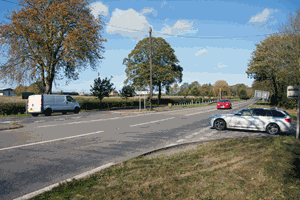
B
C
D
Correct Answer: A
Explanation: Before emerging right onto a dual carriageway, make sure that the central reservation is deep enough to protect your vehicle. If it isn't, you should treat the dual carriageway as one road and check that it's clear in both directions before pulling out. Neglecting to do this could place part or all of your vehicle in the path of approaching traffic and cause a collision.
Explanation: Before emerging right onto a dual carriageway, make sure that the central reservation is deep enough to protect your vehicle. If it isn't, you should treat the dual carriageway as one road and check that it's clear in both directions before pulling out. Neglecting to do this could place part or all of your vehicle in the path of approaching traffic and cause a collision.
25. You're waiting to emerge from a junction. The windscreen pillar is restricting your view. What should you be particularly aware of?
Mark one answer
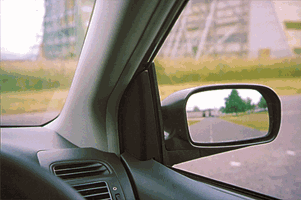
B
C
D
Correct Answer: D
Explanation: Windscreen pillars can completely block your view of pedestrians, motorcyclists and cyclists. You should make a particular effort to look for these road users; don't just rely on a quick glance.
Explanation: Windscreen pillars can completely block your view of pedestrians, motorcyclists and cyclists. You should make a particular effort to look for these road users; don't just rely on a quick glance.
26. How can you make sure that a satellite navigation (satnav) system doesn't distract you when you're driving?
Mark one answer
B
C
D
Correct Answer: C
Explanation: Satnavs can be useful when driving on unfamiliar routes. However, they can also distract you and cause you to lose control if you look at or adjust them while you're driving. Set the satnav before starting your journey, or pull up in a safe place before making any changes to it.
Explanation: Satnavs can be useful when driving on unfamiliar routes. However, they can also distract you and cause you to lose control if you look at or adjust them while you're driving. Set the satnav before starting your journey, or pull up in a safe place before making any changes to it.
















